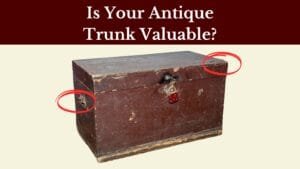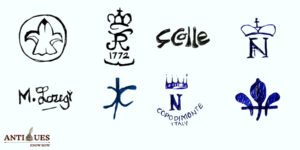Do you have old milk cans tucked away in your shed? If yes, then it’s time you take them out because there’s a high chance they can make you rich! These antique cans saw the rise of different eras, from horse-drawn carriages to automobiles, being a collector’s paradise!
But the question is, how would you know how old a milk can is? Well, from its design to the markings etched into its metal, each milk container can holds secrets that unravel its age. So, join me in studying all those features to date and appraise these valuable old milk cans!
Key Takeaways
- Old milk cans might not have marked dates, but you can use their patents, model numbers, and location marks to date them correctly.
- Pick milk cans with hand-molded wood, tin, copper & cast-iron sides for an old make.
- The earliest milk cans had flat or dome-shaped lids, while the later cans (1900s) used tighter screw-on or gasket lids.
- Barewood or handpainted black & white cans belong to the 1800s, while those with shiny red & blue colors might be new 1900s milk cans.
Key Features of An Old & Antique Milk Can

Of course, stamped patents and serial numbers help us track the age. But you can also identify old milk cans with the following marks and design features:
- Producer’s stamp with the dairy’s name, area, and region
- Thick, cylindrical cans with a rounded base and conical top
- Double-walled cans with extra insulation for cooling
- Pouring spouts and vents to balance the vacuum
- Simple flat or dome-shaped lids with seals
The Interesting History & Evolution of Antique Milk Cans
Do you know that in the early 1700s, people used old wood and clay pots to transport milk? For proper temperature, they added animal skin and hide insulation, too. But, these pots were so fragile and leaked easily.
Then, by the 1830s, dairy farmers had moved to simple tin and copper cans. And since these used hinged lids, they had better temperature and spill control. But they were heavy, and carts couldn’t carry them for long.
So, in the 1900s, makers shifted to galvanized steel cans. They were thin and insulated, with cylindrical walls and a conical top for pouring. They also had extra features like spouts, handles, and pedestal bases for balance.
However, during the Depression, there was a severe metal shortage. So, milk farmers switched to plastic and glass bottles, making old milk cans more collectible!
5 Types of Old Milk Cans (With Dates, Prices & Features)

If you want to know your old milk cans date, you MUST sort them into these five types below:
| Old Milk Can Type | Year | Top Identifying Features | Estimated Value |
| Standard Churn Design | 1870s | Cylindrical tanks with conical steel tops, sealing lids, and two side and central handles | $40 – 200 |
| Bulbous Cans | 1880s | Round or bulbous cans with soldered edges and vented caps | $50 – 300 |
| Slender Milk Cans | 1920s | Tall & sleek milk cans with aluminum or steel walls & flat bases | $20 – 150 |
| Household Cans | 1800s | Small tin, copper, or brass cans with tight, sealing lids and flat bases | $30 – 200 |
| Specialty Milk Cans | 1900s | Unique, designer cans with special spouts, handles, lids & pedestal bases | $60 – 250 |
Old standard churn cans made in the 1800s have a standard © mark, whereas the 1900s ones use a ® symbol.
6 Factors to Date Old Milk Cans & Find Their Worth
Yes, old milk cans cost $25 – 200 if they are in good condition, with prominent marks and codes. In fact, some old, handmade wood or tin ones might value up to $300 too. If you are not sure how old your milk can is and its actual worth, here are other factors like marks and materials to date it:
1. Marks & Numbers

Do you know that old milk cans from different eras have different marks and stamps? For instance, the earliest 1800s cans had location marks, while the 1900s ones used patents. So, let’s see how to use each of them to date your milk can:
Patent Numbers: If your milk can has a stamped, 4 – 10 digit patent number on its base or lid, it might be a 1900s model. Also, look for metal-reinforced bases, labels, and engraved ‘US’ or ‘EU’ stamps with them. Here are a few examples:
| Vintage Milk Can Patent Number | Year | Age | Estimated Value |
| US1921247A (Cylindrical Milk Cans) | 1932 | 91 years | $20 – 150 |
| US2268763A (Milk Can with Covers) | 1939 | 84 years | $20 – 150 |
| 2268763 (Milk Can with two side handles) | 1900 | 114 – 123 years | $50 – 300 |
| 1921247 1933 (Milk plus cream can) | 1942 | 81 years | $50 – 200 |
Location Marks: Vintage milk cans with embossed country codes or ‘Made in USA’ stamps date back to the 1800s or 1900s. Some of these have the dairy’s mascot, logo, and initials under them.
Let’s see how to date such specific country marks below:
| Old Milk Can Location Mark | Year | Age | Average Cost |
| 05-1234: California | 1909 – 1960s | 63 – 114 years | $50 – 200 |
| 03-4567: Arizona | 1910 – 1960s | 63 – 113 years | $30 – 100 |
| 10-7890: Georgia | 1911 – 1960s | 63 – 112 years | $30 – 100 |
| 20-9012: Maryland | 1912 – 1960s | 63 – 111 years | $20 – 90 |
| 32-0123: New York | 1913 – 1960s | 53 – 110 years | $20 – 90 |
Model or Serial Numbers: Does your old milk can have a stamped serial number on its base or handle? If yes, it might be a new 1900s model with machine-finished or soldered edges. But if you want to know the exact years, check the table below:
| Antique Milk Can Serial Numbers | Year | Age | Average Price |
| 123456 | 1900 – 1960s | 63 – 123 years | $50 – 200 |
| 654321 | 1900 – 1960s | 63 – 123 years | $50 – 200 |
| 987654 | 1920 – 1940s | 83 – 103 years | $30 – 100 |
| 432198 | 1930 – 1950s | 73 – 93 years | $20 – 100 |
| 765432 (Rare, Limited Edition number) | 1940 – 1960s | 63 – 83 years | $50 – 300 |
Food Labeling Phrases: Antique milk cans with a proper ingredient list or exact sugar and salt content stamps were popular in the early 1900s. So, check for such phrases on the bronze or printed paper label, and verify them from our list:
| Old Milk Can Food Labels | Year | Age |
| Cure | 1800 – 1906 | 117 – 223 years |
| Hermetically Sealed | 1900 – 1920 | 103 – 123 years |
| Packed in Sanitary Cans | 1900 – 1920 | 103 – 123 years |
| Salt Added | 1920 – 1930 | 93 – 103 years |
| Good Housekeeping Seal of Approval | 1910 – 1920 | 103 – 113 years |
| Patent Pending | 1940 – 1960 | 63 – 83 years |
| Sugar Added | 1920 – 1930 | 93 – 103 years |
Capacity stamps: One of the key features of the 1900s milk cans, capacity marks indicate the can’s size and milk content. So, rotate your can and check for such ‘5,’ ‘10,’ or ‘20-gallon’ marks on its base, sides, handles, or lids.
Try to get antique milk cans with paper or bronze labels with the dairy’s address, area, and 4-digit phone number for more returns.
2. Can Materials

Well, the earliest 1800s milk cans might have crude wood, tin, or copper sides. But, with the advent of the 20th century, makers focused on light & insulative steel & aluminum cans.
And not only can you spot and date old milk cans, but you can also appraise them with the help of materials:
| Vintage Milk Can Materials | Years | How to Identify? | Estimated Price |
| Wood | 1830 – 1850 | Planked & bonded sides with cross-metal bands at regular intervals | $40 – 250 |
| Tin or Copper | 1830 – 1870 | Cylindrical cans with rounded or flat tops and a bluish-green patina | $30 – 200 |
| Cast & Alloyed Iron | 1830 – 1900 | Thick, heavy & blackish cans with powdered, matte surfaces | $50 – 250 |
| Galvanized Steel | 1870 – 1930 | Thin, silver-gray cans with simple, conical, or flat tops and embossed dairy stamps | $30 – 150 |
| Aluminum | 1920 – 1960 | Shiny and streamlined cans with a whitish surface | $40 – 100 |
| Stainless Steel | 1940 – 1960 | Thin, shiny & reflective surfaces with engraved stamps & dairy names | $30 – 90 |
Pick old milk cans with a natural patina, enameled or painted finishes for an old make.
3. Brands & Manufacturers

Does your old milk can have a signed brand name, logo, or mascot on its walls or sides? If yes, it might be the 1800s or 1900s branded milk can. So just note its name, and verify the exact years and cost from our table below:
| Antique Milk Can Brands | Years | Unique & Collectible Features | Estimated Value |
| DeLaval | 1870 – 1950 | Superior galvanized steel cans with conical tops and signed ‘Delaval’ markings | $80 – 300 |
| Buhl | 1870 – 1950 | Cast iron or steel cans with engraved brand & capacity marks | $100 – 400 |
| Superior | 1900 – 1960 | Simple, conical milk cans with a signed ‘Superior’ mark on the base | $70 – 250 |
| Sensible | 1900 – 1930 | Steel or Aluminum cans with conical lids and printed labels | $80 – 300 |
| The International Harvester Company (IHC) | 1870 – 1950 | Tin, Iron, or Steel cans with a printed company label or sticker | $100 – 500 |
Look for antique milk churns with soldered metals, physical grooves, and handles for a branded make.
4. Churn Colors

The earliest 1800s cans used natural wood or tin colors, often with extra varnishing and glazing for glossiness. In contrast, the 1860s ones used white and black paint, whereas cans from the early 1900s moved to galvanized red and blue finishes.
So, let’s check how to date and appraise this aging factor:
| Old Milk Can Colors | Average Value |
| Black, Gray & White | $50 – 200 |
| Cream & Brown | $50 – 150 |
| Red & Orange | $30 – 120 |
| Metallic Silver or Pewter | $50 – 150 |
| Green & Olive | $30 – 100 |
| Blue, Teal & Purple | $30 – 100 |
5. Lids & Closures

Want a quick visual test to date and appraise your old milk cans? Just open their covers and observe the lids. If they are flat, you might have an old, handmade milk can. But if they are domical or screwed, it might be a new 1900s can.
But how will you use the lid design to date your milk can? Find out below!
| Antique Milk Can Lids | Years | Special Features | Estimated Cost |
| Flat Disc Lids | 1870 – 1930 | Simple, flat discs with sealed mouths and a side handle for removal | $50 – 200 |
| Dome-shaped Lids | 1900 – 1950 | Round or bulbous lids with a central handle for grip | $40 – 150 |
| Screw-on Lids | 1920 – 1950 | Elongated lids with grooved & threaded mouths for a tight seal | $40 – 100 |
| Locking Lids | 1900 – 1930 | Double-level lid with concealed locks on both sides | $30 – 90 |
| Lids with Gaskets | 1900 – 1960 | Simple, round lids with extra rubber or silicone gaskets for a tight seal | $30 – 90 |
Try to get old milk cans with perforated milk can covers or vessels as those are old, roughly from 1820 to 1930.
6. Can Capacity
Another visual clue to identify and date your old milk churns! The old 1800s milk cans were small, with a low capacity of 3 – 5 gallons, but the later 1900s ones had large, 10 – 20-gallon tanks.
Here’s a list of such different milk can sizes, their uses, and years below:
| Old Milk Can Capacity | Years | Uses | Average Cost |
| 3 – Gallon Milk Cans | 1870 – 1950 | Household or transportation | $50 – 200 |
| 5 – Gallon Milk Cans | 1870 – 1950 | Farm & agricultural Use | $70 – 200 |
| 8 – Gallon Milk Cans | 1900 – 1950 | Used for farms with higher milk production capacity, transportation & Storage | $50 – 150 |
| 10 – Gallon Milk Cans | 1900 – 1950 | Used for commercial dairies & regions with high milk production | $50 – 250 |
What Do the Numbers on Old Milk Cans Mean?
The 4-10 digit embossed or stamped numbers could signify a milk can’s patent number, capacity, or location codes. And if the milk can is branded, it could mean a specific model or serial number, too!
What Were Old Milk Cans Called?
Old milk cans were also called ‘milk pails,’ ‘milk churns,’ and ‘dairy cans’ due to their flat, pail-like shapes and dairy logos.
How Do You Clean Old Milk Cans?
You can clean your milk tank by scrubbing it with warm water and powdered soap. But if your can has a lot of rust, rub it lightly with sandpaper, and coat it with wax.
Old milk cans might look small and plain at first glance, but these hold tremendous value when identified and dated correctly. For this, observe the can, and check for any patents, location marks, or numbers on the surface. And if you don’t find them, move on to the materials and other visual clues.
Want to identify more farm-related antiques? If yes, my detailed identification guides on ‘Antique Stone Axes,’ ‘Broad Axes,’ and ‘Plows’ are all you need!
Note: This article is intended for informational, educational, and entertainment purposes only. Some images are illustrative and may not represent actual brands, products, or related entities. All trademarks, product names, brand logos, packaging, and other intellectual property referenced remain the exclusive property of their respective owners. Any brand mentions or references are provided solely for descriptive and educational context and do not imply any formal or commercial association.










